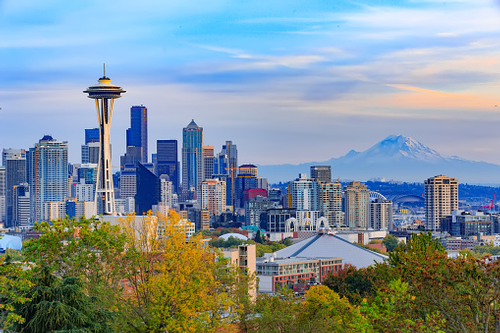FRIDAY, FEBRUARY 5, 2021
At the beginning of the week, Seattle City Council unanimously approved Commercial Energy Code updates set forth by Mayor Jenny Durkan that seek to advance electrification throughout the commercial and residential building sectors.
The new ordinance bans natural gas for space heating in new construction of commercial and multi-family residential buildings that are taller than three stories.
The Updates
Durkan proposed the legislation in mid-January and is part of a broader city effort to reduce greenhouse gas emissions—including a carbon neutral goal by 2050.

 |
| aiisha5 / Getty Images |
|
At the beginning of the week, Seattle City Council unanimously approved Commercial Energy Code updates set forth by Mayor Jenny Durkan that seek to advance electrification throughout the commercial and residential building sectors. |
“2020 and 2021 will be remembered as years of crises, and as we recover, Seattle can create a more equitable city with green buildings. It is up to Seattle and other cities to make the bold changes necessary to lower our greenhouse gas emissions,” said Durkan.
“Business as usual will not get us to a future where all Seattle residents, especially our Black, Indigenous and people of color neighbors who are unfairly burdened by environmental inequities, enjoy a healthy and prosperous future. Electrifying our buildings is an important step in the many actions needed to curb climate pollution.”
The Code updates include key changes such as:
The amendments do, however, continue to allow the buildings to be construction with natural gas for cooking, though electrical outlets are also mandated so that the space could be converted later.
The code also does not extend to construction of single-family homes, which have energy codes set by the state that continue to allow natural gas for heat.
Natural gas industry officials caution the move, looking to an already-strained energy grid. Moreover, Puget Sound Energy, which provides natural gas to about 150,000 customers in Seattle, has its own carbon emissions goal of a 30% reduction by 2030.
And local developers voiced their dissent to the changes, such as Benjamin Maritz who reportedly spoke out at the council meeting, noting that the new codes could add around $15,000 to construction costs, which would ultimately be passed down to the tenants.
Most of the code changes will go into effect next month, while some won’t kick in until January 2022.
Recently, in San Francisco
Seattle is just the latest city to adopt stricter building codes when it comes to energy. Last November, San Francisco’s Board of Supervisors unanimously passed a new city ordinance, banning the use natural gas or other fossil fuels in all new residential and commercial building construction projects.
The vote arrives after almost a year of deliberation with the Zero Emissions Building Taskforce, which brought together affordable housing and mixed-use developers, architects and engineers, labor and building trades and community advocates to write the legislation.
The new ordinance complements legislation the city passed last year, transitioning private commercial buildings of 50,000 square feet and larger to 100% renewable electricity by 2030.
The legislation was part of Mayor London N. Breed’s vision of an “all-electric City” in which 100% renewable electricity replaces the use of fossil fuels in the building and transportation sectors. According to the mayor’s news release, roughly half of the city’s emissions come from buildings, and a significant portion of those emissions are released from the commercial sector.
Breed first unveiled the plan amending San Francisco’s existing environment code for all non-residential buildings on Earth Day in April 2019—a plan similar to New York City’s Climate Leadership Bill. However, instead of cutting emissions from the city’s largest buildings, San Francisco would opt to specifically require buildings to run on electricity generated by 100% renewables, a first for U.S. cities.
In implementing the new legislation, the city is expected to reduce 21% of emissions from commercial buildings by 2030, when the entire city aims to run on 100% renewable electricity. Of the city’s total emissions, buildings and transportation are estimated to make up about 90%, respectively.
Because the plan is based on a building’s size, the timeline to go fully renewable is as follows:
At the time the legislation was approved, San Francisco reported that the city had already reduced its greenhouse gas emissions by 36% in comparison to its 1990 levels. San Francisco was also ranked as one of the top five cities for clean energy in July 2019 by the American Council for an Energy-Efficient Economy, a nonprofit that promotes efficient energy policies.
However, according to the California Air Resources Board, residential and commercial buildings are still responsible for roughly 25% of California’s greenhouse gas emissions.
Reports indicate that the latest ordinance banning natural gas is just the latest in the state’s nearly 40 cities to pass such ordinances since Berkeley's historic ban on natural gas infrastructure July 2019. In citing the potential cost savings, public health benefits and reduction in greenhouse gas emissions, experts believe that soon, similar legislation from cities such as Los Angeles could follow, and possibly, Gov. Gavin Newsom could push a statewide action.
The new ordinance requires that these projects adopt all-electric power, starting in June 2021, and plans to cover about 60% of the city’s current development pipeline in an effort to reduce carbon emissions and tackle climate change. However, an amendment to the ordinance allows restaurants to apply for a waiver through the end of 2022 to use a natural gas stove.
Tagged categories: Building codes; Energy codes; Good Technical Practice; Government; Regulations